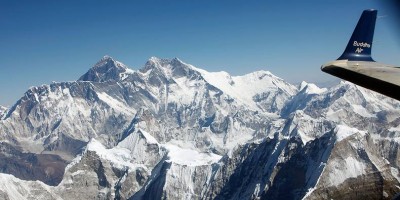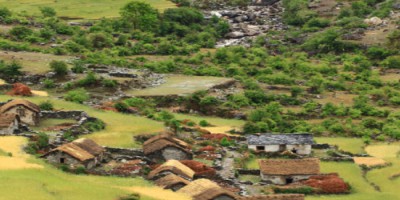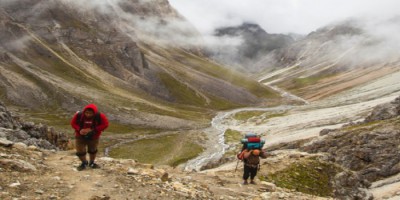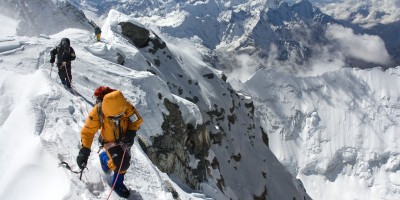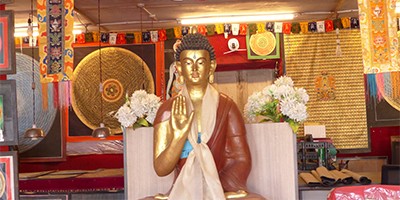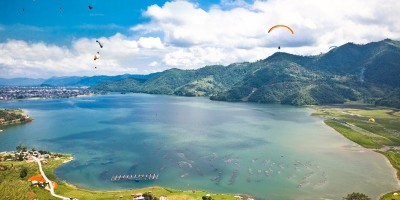Nepal
Know about Nepal
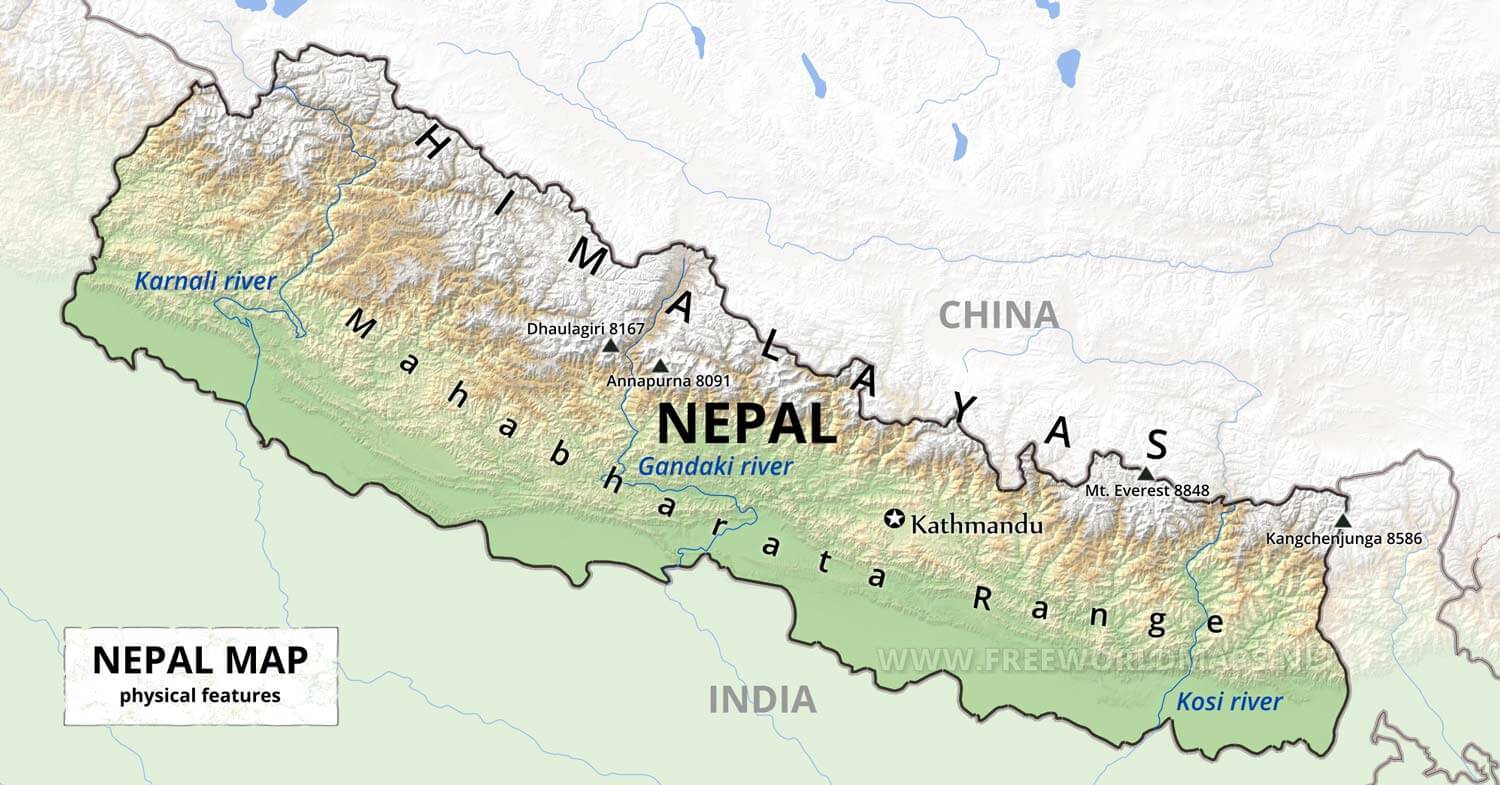
Namaste........
Nepal is called an Amazon of Asia. The hidden treasure of its rich biodiversity is not yet fully explored. The most baffling fact about Nepal is that all of the following happens within the Small area of 147,181 sq. km (56,827 sq. mi). Nepal occupies only 0.3 and 0.03 percentage of land area of Asia and the world respectively.The country is great example of unity in diversity.
NEPAL
General Information:
Location: Between India & the Tibetan Autonomous Region of the People's Republic of China.
Area: 147,181 Sq. Kms.
Latitude: 26° 12' and 30° 27' North.
Longitude: 80° 4' and 88° 12' East.
Capital: Kathmandu
People: Over 40 Ethnic Groups & 70 Spoken Languages.
Political-System:Multiparty Democracy system.
Topography: From the world's deepest gorge 'Kali-Gandaki' to highest point on earth 'The Everest'.
Vegetation: Nepal possesses some of the most outstanding bio-diversity in the world, ranging from sub-tropical Rain-forests to Alpine deserts.
Weather: Climate ranges from Tropical in the low lands to Arctic in higher altitudes.
Seasons: Winter (December-February), Summer (March-May), Monsoon(June-Aug),Autumn(Sept-Nov)
Monsoon: Mostly rains at night, making the following days crispy clean and fresh. Most of the northern belt of the Trans-Himalayan zone is rain-shadowed and ideal for trekking.
National Bird: Impean Pheasant (Danfe).
National Flower:Rhododendron Arboreum (Lali Gurans). One of the few countries in the world where Seven World Heritage Sites are situated within 20 kms. of radius.
Endangered Species:]Tiger, Rhino, Snow - leopard, Red panda, Brown bear, Assamese macaque, Gangetic dolphin, Wolf, Wild elephant , Giant horn-bill, Swamp deer, Wild yak, Tibetan antelope, Black buck, Four horned antelope, Musk deer, Pigmy hog, Haspid hare, Pangolin, Gharial, Indian bustard, Saras crane, Impean pheasant, Python.
Wildlife:One horned rhino, Royal Bengal tiger, Snow-leopard, Clouded-leopard, Red panda, Blue-sheep, Long snouted fish eating Gharial, wild elephant , buffaloes, bisons, blue bull, brown bear, leopard, crocodiles and many varieties of cat, dog, deer and antelope fmilies and 840 different species of wet-land, migratory and residential birds.
A Living Cultural Heritage:Our heritage is alive and dynamic. Shamanism, Pan-animism & Witch-craft are still practised in remote regions. Temples, shrines, monuments and monasteries are extremely active with devotees burning butter-lamps, singing hymns, chiming temple bells and playing drums.
THE CULTURE, WE ARE TALKING ABOUT:Nepal is the only Kingdom in the world to have a Hindu by tradition.The Kingdom of Nepal is home to numerous races and tribes. It is a nation immensely rich in art, culture, religions and traditions. The religious and ritual diversities among the Nepalese ethnic groups have led to the saying that Nepal has more deities than people, and more festivals than there are days in the calendar.
Among the peoples of Nepal, the Sherpas inhabit the country in the northern and eastern region. They have strong influence of Tibetan culture and civilization. The midland hills and valleys are inhabited by various other Tibeto-Burman and Indo-Aryans. Nepalese of Indian descent inhabits the Terai lowlands. All these lead to a myriad of intricately interwoven cultures, religions, ways of life and traditions. Apart from the two dominant religions - Hinduism and Buddhism - the ancient beliefs of Bonpo, shamanism and animism still prevail in the untouched and remote corners of the nation. Then there are the latter-day developments of such religious practices as power worship, Tantrism, Jainism, Christianity and Islam. The influences of religions and cultures are eminent in various forms of art, including painting, sculpture, woodcarving, architecture, stone works, terracotta and metal-craft.
Wood-carving, architecture etc
Culture with the uniqueness...
Nepal – A brief description: Nepal, represented to the world by the highest peak, Mt. Everest and Lumbini, the birthplace of Lord Buddha, is not only the home of high snow clad mountains but home to various ethnic groups with diverse cultures, religions and languages. Nepal, though a small country situated between India and China, is one of the few countries in the world where such spectacular diversity in climatic as well as topographic features is so dramatically combined within such a small area. North of Nepal is covered by snow clad mountains with cold alpine type climate, middle region by hills with temperate climate and the southern region is covered by plain terai region with very hot tropical-climate.
The Himalayan and hilly landscape attract people for numerous adventure activities including mountaineering, trekking, hiking, mountain biking, helicopter sightseeing, para gliding, hang gliding and other adventure activities.
Due to the wide range of climatic and topographic features, Nepal is also rich in biological diversity ranging in a wide variety of flora and fauna, unparalleled elsewhere in the world. Nepal also attracts tourists for its art and culture. Various religions coexist harmoniously among the multitude of ethnic groups that form the people of Nepal. Because of the unparalleled diversity in culture, religion, topography, language, flora and fauna, Nepal attracts tourists for culture, adventure, and nature.
Culture, Adventure, Nature Experience all in Nepal.
We would like to take you to a brief tour about Nepal.
Some Interesting Destinations, you might want to visit among.... other unique unlimited destinations!
Kathmandu:
Being a country of extreme topographical contrasts within a north-south distance of merely 150 kms, the land rises from near sea level in the south to over 8,000 meters in the North. Nepal has been endowed with a great diversity of terrain and climes. Few destinations in the world can match Nepal in the variety of adventure tourism available, be it mountaineering, trekking, mountain biking, white-water rafting, kayaking, canoeing, mountain flights, hot air ballooning, hang-gliding, ultra-light aircraft ride, pony trekking, nature tours, culture tours, jungle safaris, bird watching, and fishing. There are still many destinations and products waiting to be developed in Nepal.
Nepal: The ultimate destination for adventure!
Being a country of extreme topographical contrasts within a north-south distance of merely 150 kms, the land rises from near sea level in the south to over 8,000 meters in the North. Nepal has been endowed with a great diversity of terrain and climes. Few destinations in the world can match Nepal in the variety of adventure tourism available, be it mountaineering, trekking, mountain biking, white-water rafting, kayaking, canoeing, mountain flights, hot air ballooning, hang-gliding, ultra-light aircraft ride, pony trekking, nature tours, culture tours, jungle safaris, bird watching, and fishing. There are still many destinations and products waiting to be developed in Nepal.
With eight of the highest peaks in the world, Nepal has been the focus of some of the most outstanding achievements in the world of mountaineering. The dauntless icy peaks have, since decades, challenged the minds and bodies of those who dare!
Currently, there are more than 150 peaks opened for mountaineering, including the highest of them all - Mt. Everest. Climbing permit to scale the Nepal Himalaya as is issued for all seasons.
SIGHTSEEING
IN AND AROUND KATHMANDU :
Kathmandu City :
Known as Kantipur, the capital of the Kingdom of Nepal. Here you will visit the temple of the Living Goddess. Kashtamandap - the source of the name Kathmandu and supposed to be made from the timber of a single tree and the Durbar Square are with its array of temples overlooked by the Hanuman Dhoka Palace, the ancient place of the Nepalese Royalty.
Swayambhunath :
Located approximately 4 kms./2.5 miles, this Buddhist Stupa is said to be 2000 years old. The Stupa which forms the main structure is composed of a solid hemisphere of brick and earth supporting a lofty conical spire capped by a pinnacle of copper gilt. Painted on the four sided base of the spire are the all seeing eyes of Lord Buddha. This hill is a mosaic of small Chaityas and Pagoda temples.
Pashupatinath :
Situated 5 kms. east of Kathmandu City, Pashupatinath temple is one of the holiest temples dedicated to Lord Shiva. Situated amidst a lush green natural setting on the bank of the sacred Bagmati river, the temple built in pagoda style has gilted roof and richly carved silver doors. Visitors will be permitted to view the temple from the east bank of Bagmati river, entrace in the temple being strictly forbidden to all non Hindus. Pashupatinath is the centre of annual pilgrimage on the day of shivaratri which falls in the month of February/March. Behind the temple are the cremation grounds.
Boudhanath :
This Stupa, 8 kms. east of Kathmandu City, is one of the biggest in the world of its kind. It stands with four pairs of eyes in the four cardinal direction keeping watch for righteous behaviour and human prosperity. This Buddhis Stupa was built by King Man Deva at the advice of the Goddess Mani Jogini. It is built on an octagonal base inset with prayer wheels. The shrine is ringed by houses of Lamas or Buddhist priest.
Budhanilkantha:
It is situated about eight kilometers north of Kathmandu at the foot of Shivapuri range. The Vishnu statue of Budhanilkantha was found buried in the ground in its original state. The staute is estimated to be thousand years old and shows Vishnu lying on the cosmic water before the universe was created. Shivputi looms over Budhanilkantha and visitors find much peace there. Here one can see the image of Vishnu reclining on the bed of snakes dating back to 5th century AD. You will be able to observe local people perform puja every morning and evening.
Patan :
5 kms./3 miles away from kathmandu City. Patan also known as Lalitpur, is the city of fine arts, encloosed within 4 stupas said to be built in 3rd CenturyAD by Emperor Ashoka. You will see the Durbar Square, the Patan Durbar which houses a bronze collection, the Krishna Temple built by King Siddhi Narsingh Malla, Hiranya Varna Mahavir and Mahaboudha Temple.
A trip to the Tibetan Refugee Camp and the Handicraft Centre will also be done while, visiting Patan where you will witness the hand weaving of Tibetan carpets and moulding of metal statues.
Bungamati :
A typical Newar village, lying 11 kms./7 miles south of Kathmandu, founded in 7th Century AD, possesses one of the most important God of Kathmandu Valley known as Matsyendranath - the God of rain and compassion, worshipped equally by Hindus and Buddhists. He was accredited by the people for introducing rice plantation in the valley. A tour of this village combined with Khokana imprints a beautiful impression on the visitors’ mind through its set up and primitive way of living.
Balaju:
The Balaju Water Garden has been the focus of several Nepali folk songs. The fish farm, the forests, the water falls and the plants here are beautiful, and the 22 sea-dragon spouts are a site of religious festival. Located at the foot of Nagarjun Hill, it has plenty of water resources and is favorite picnic spot.
Harisiddhi :
This is a small village 10 kms./6 miles south east of Kathmandu. It is a very unique village in the sense that no villagers wear leather shoes inside the village. All visitors are requested to wear cloth shoes while visiting this village. A tour of Harisiddhi can be done in conjunction with Godavari or Phulchowki.
Bhadgaon :
Also known as Bhaktapur meaning city of devotees, this place is the home of medieval art and architecture. Lying 14 kms./9 miles east of Kathmandu City, this place was founded in the 9th Century and is shaped like a conch shell. The city is at the height of 4600 ft. above sea level. In Bhadgaon, you will visit the Durbar Square with its array of temples overlooked by the Palace of 55 windows built by King Bupatindra Malla. The Nyatapola Temple, also built by King Bhupatindra Malla, is the best example of Pagoda style and stands on five terraces on each of which stands a pair of figures - two famous strong men, two elephants, two lions, two griffins and two goddesses. Time permitting, a visit to the museum of Thanka painting can also be considered.
Thimi :
Clay pottery is the traditional occupation of this village which is on the way to Bhaktapur. Here, one can witness the making of clay pots, flower vases etc. and buy them very cheaply if they so desire.
Banepa :
Capital of entire region in the middle of the 15th Century, this small commercially active Newar Village city has catered to the people of the neighbouring areas unnoticed to its own past. When Nepal had trade relations with Tibet, this place was an important enroute trade centre. Tour of this villages gives a good combination of history, rural life and scenic beauty.
Dhulikhel :
Situated at an altitude of approximately 1600 ms./5500 ft. above sea level and 32 kms./20 miles east of Kathmandu, it is famous for its vantage location in viewing the Himalayan ranges from Cho Oyu in the east to Himalchuli in the west. Dhulikhel is very popular for viewing sunrise and sunset.
Changunarayan :
The temple of Changunarayan, located at a distance of 14 kms./9 miles, is universally acknowledged as the most stately example of Pagoda style in Nepal. It is considered to be one of the greatest artistic legacies of the Lichhavian era. Changu is one of the ancient historical places situated on a hillock with conical shape. It is said to be the oldest pagoda style temple in the valley from early 3rd Century AD.
Dakshinkali :
Literally meaning the Kali of the south, this temple is dedicated to Goddess Kali, a Hindu Goddess of power. A sacrifice ceremony of goats, chickens, ducks etc. is held every Tuesdays and Saturdays. The temple itself is located in a forested canyon and lies 19 kms./12 miles from Kathmandu.
Daman :
Situated at a height of 2100 m./7500 ft. above sea level and a distance of 80 kms./50 miles, Daman is known for its vantage location in viewing the Himalayan peaks such as Mount Everest, Annapurna, Manaslu, Ganesh Himal, Langtang, Dorje Lakpa, Gauri Shankar, Cho Oyuetc. There is a view tower from where one can have a panoramic view of 300 miles of the Himalayan range.
Godavari :
Situated 16 kms./10 miles from Kathmandu, Godavari located at the lap of Phulchowki hill is well known for its prizzed butterfly population including rate collector’s items. The Royal Botanical Garden also located here has a wide ranging collection of high altitude orchids and cacati. This place is also recommended to the bird watcher.
Kakani :
This is about 28 kms./17.5 miles north west of Kathmandu. Besides the view of the Himalayan peaks like Manaslu, Himalchuli and Annapurna, it is also famous for its landscape. Wild animals and birds are avilable in the forest of Kakani.
Kirtipur :
It is a small towm 8 kms./5 miles south-west of Kathmandu on top of a hill near Tribhuvan University. This historical town has many things to offer - old shrines, temples and old houses. One can also witness people in traditional costumes weaving their requirement of cloth on looms.
Chovar :
This is 8 kms./5 miles south west of Kathmandu. ‘Chovar’ is famous for its gorge which is said to have been cut by Manjushree to drain the water out from Kathmandu Valley which was then supposed to be a lake. This gorge is the only outlet for all ,the rivers of then valley and is always combined with the excursion to Dakshinkali.
Khokana :
Khokana is a small Newar village on the southern flank of Kathmandu and about 11 kms./7 miles from Kathmandu established in 7th Century AD by the mighty Licchhavi rulers of Nepal. It is a unique village in the whole of Kathmandu valley because of its aloofness from modern civilization.
Kodari :
This is the border point between Nepal and Tibet Region of People’s Republic of China. The 114 kms. road from Kathmandu takes about 4 to 5 hours each way. It is a beautiful drive through country side. On this road one can see beautiful mountains, snow fed rivers, natural hot spring, village life etc.
Muktinath:
The famous temple of Lord Muktinath lies in the district of Mustang and is situated about 18 kilometers northeast of Jomsom at altitude of about 3,749 meters. The temple is situated on a high mountain ranges and is visited during fair weather. There are many ways to get Muktinath from Kathmandu. Either take flight from kathmandu to Pokhara and halt one night in Pokhara nd next morning fly to Jomsom and hikd about 7/8 hours via Kagbeni or trek all the way from Pokhara or charter a Helicopter and teach to Muktinath.
Nala :
Nala is a small isolated village 27 kms./17 miles east of Kathmandu situated on the southern slope of a mountain overlooking the beautiful green valley. The whole village has gained a mystical atmosphere due to its set up and a typical temple of Bhagawati a classic example of pagoda architecture. There is also a 9th Century AD temple dedicated to Lord Lokeshwor - a Buddhist God.
Nagarjun :
Nagarjun is about 10 kms./6.2 miles from Kathmandu. There is a Buddhist shrine at the top which is very holy for both Buddists and Hindus. To reach the top one has to climb for about 15 to 20 minutes. From this point a panoramic view of the Himalayan range can be seen.
Nagarkot :
This is situated about 35 kms./22 miles east of Kathmandu and from here, one can see Mount Everest and other peaks of the Himalays. Nagarkot is located between Kathmandu Valley in the west and Indrawati in the east. The top of Nagarkot commands acclerating views in all directions. The altitude of Nagarkot is 2229 m./7133 ft. above sea level.
Namobuddha:
The hike from Dhulikhel to Namobuddha takes about two hours. It is relatively easy and passes through some typical villages such as Kawe (Kavre) and Phulbari before reaching the Buddhist monastery and stupa at Namobuddha, an important destination for Buddhist pilgrims. In namobuddha , it belives buddha also visited.
On the hill above Namobuddha is a famous stone tablet (left) depicting a Buddha (there have been many before the historical Buddha) feeding himself to a starving tigress and her cubs. This is from a famous Buddhist tale expressing the great compassion of the Buddha.
Panauti :
Panauti is an ancient village, 32 kms./20 miles south east of Kathmandu, situated on the banks of Puyamati river. A leisurely walk through this tiny village will reveal its antiquity to the visitors, a must in Panauti is a visit to the 14th Century AD Hindu temple of Shiva locally known as Indreswor Mahadev. The wooden struts supporting the temple are splendid example of wood carving of that era which till date remain unchallenged I the entire Kingdom.
Phulchowki :
It is one of the most prominent peak 2829 m./9050 ft. high which surrounds the valley of Kathmandu. This mountain, as its name suggests (Phul means flower in Nepali) is a natural garden of wild roses, yellow jasmine, iris and other native flowers. The summit is a rich grove of rhododendrons of various hues. A jeepable road leads to the top of the hill where there is a Buddhist shrine. A youthful hiker stands a good chance of scaling the peak in a little more than three hours. The place has all the makings of a peaceful resort area.
Sankhu :
Sankhu is a small village 20 kms./12 miles north east of Kathmandu. This village was the last stop for the traders going to Lhasa from 7th till 19th Century AD. The villagae is a legend in itself. Here, one can also see a beautiful temple of Bajra Yogini, a Buddhist Goddess of power, if one is willing to walk for 50 minutes uphill.
Palanchowk:
This half-day walk combines breathtaking mountain views with a visit to a scared temple. Following breakfast you'll drive about one hour to Palanchowk. Here you'll visit the Bhagwati temple, which houses one of the most beautiful and most important Bhagbati images in Nepal. The stunning image is carved of black stone and decked
with jewlerry. Many pilgrims visit this site, especially on tuesdays and Saturdays, when sacrifices are made. From your hilltop vantage point you'll have spectacular view of the Himalayas and the surrounding Valleys. After exploring the mountain village of Palanchowk you will walk down the Panchkhal Valley, following an old path used by local resident. The unfolding drama of the Himalayan landscape is revealed as you follow the trail, looking at the mountains from different angles. Once you reached the Panchkhal Valley, your vehicle will meet you for the return to Dhulikhel.
Tika Bhairav :
A small peaceful spot 16 kms./10 miles south of Kathmandu is named after the Tantric God Bhairav. One can combine this place with 3 typical Newas villages of Chapagaon, Sunakothi and Thecho. Of all the villages, Chapagaon treasures one of the earliest statues of Brahma - the Hindu God of creation - from the early 7th Century AD and thus deserves special attention.
Tokha: A very interesting place to enjoy
Tokha is a typical Newari place full of cultural and religious background ............where u can enjoy a lot in 'bhootkhel' ----a Ghostground...that this ground is preliminary called so it was used by ghost in past for their life enjoyment. Now the land has been changed into a greenery playground and pasture land too.....and picnic spot tooo. Beside this place there is still a temple of MashnKali ('God of Dead body').
Natural History Museum :
The only of its kind in Nepal is situated 3 kms. west of Kathmandu behind the famous Swayambhunath hillock. Programmed under the Institute of Science, this Museum has over 14000 unique collections of butterflies, fish reptiles, bird, mammals, plants and fossils recorded with the country. Nearby, there is another National Museum. One can have a general idea of the bistorical and archaeological objects on show since it houses a remarkable and wide range of weapons of war antiques.
Mountain Flight :
One-hour daily Mountain flight is operated by Airlines, to view the mighty Himalayan peaks including Mt. Everest. This is the closest one can go to the peaks without
having to trek. Please note that the flights do not land anywhere all you will be
offered is an aerial view. Duration of the flight will be around 45 minutes to an hour.
The aircraft will be BEECH (USA) – 18 seater and SAAB – 32 seater, but out of 32
seats, they sell only 16 seats so that every one can get window. The operation of the
flight is strictly subject to weather condition. The operation of the flight is between 07
am to 10 am only..
OUT OF KATHMANDU VALLEY :
Rapti Valley (Chitwan) :
Royal Chitwan National Park, Chitwan :
The Royal Chitwan National Park is the lush valley of Chitwan situated in the foothills of Churia ranges which houses the first National Park of the Kingdom. This National Park is famous for its variety of wildlife especially the Great Indian One Horned Rhinoceros and the elusive Royal Bengal Tiger.

